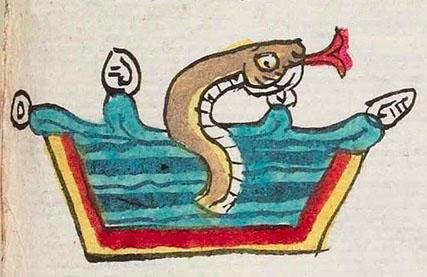Coapan (Mdz50r)
This compound glyph for the place name Coapan (or Coaapan?) has two notable features, a snake/serpent (coatl) and a cross-section of a canal or waterway (apantli). The serpent is upright and curving, but we only see half its body, as though it is partially submerged. It is shown in profile, facing to the viewer's right. Its red, bifurcated tongue is protruding. Its back is brown changing to yellow toward the belly. On the very bottom of the belly is a white, segmented stripe. The body of water is contained with a lining of yellow and, outside of that, red. The water has black stripes of different thicknesses (two especially thick black lines toward the middle), somewhat wavy, perhaps intending to show flow or motion. Coming off the top of the water are alternating white droplets/beads and white turbinate shells.
Stephanie Wood
The waterway provides the locative suffix -apan, which means on the waters of. Frances Karttunen suggests "Lake" for the type of water meant, probably given the number of lakes in the Basin of Mexico. See below right for other examples of the apantli, which can have no lining, just yellow, just red, green with yellow hash marks, or some combination. The hieroglyph for Acuitlapan has the full combination of canal linings. The reason for the varying iconography is not clear. Just a stream of water has also been used in some glyphs for the -apan suffix.
In this collection of hieroglyphs, snakes can have full bodies, or partial bodies, and they can vary in color and texture. The full-length snakes have rattlers, and sometimes the rattlers are turquoise blue in color.
There is a Santa María Coapan and a Santa Ana Coapan in the state of Puebla, a San Pablo Coapan in the state of Veracruz, and a Lago de Coapan near Toluca in the state of Mexico. Research into the surrounding communities could help isolate which Coapan had this hieroglyph. Coapan was not an unusual Nahua placename.
Stephanie Wood
coapan / puo
Coapan, pueblo
Stephanie Wood
c. 1541, or by 1553 at the latest
Stephanie Wood
snakes, serpents, serpientes, canales, canals, cohuatl, nombres de lugares, crótalos

coa(tl), snake or serpent, https://nahuatl.wired-humanities.org/content/coatl
apan(tli), canal or waterway, https://nahuatl.wired-humanities.org/content/apantli
a(tl), water, https://nahuatl.wired-humanities.org/content/atl
-apan (locative suffix), on the water of, https://nahuatl.wired-humanities.org/content/apan-0
"On Snake Lake" [Frances Karttunen, unpublished manuscript, used here with her permission.]
"On the Canal of the Snake" (Berdan and Anawalt, 1992, vol. 1, p. 179)
"En el Lago del Serpiente"
Stephanie Wood
Codex Mendoza, folio 50 recto, https://digital.bodleian.ox.ac.uk/objects/2fea788e-2aa2-4f08-b6d9-648c00..., image 110 of 188.
The Bodleian Libraries, University of Oxford, hold the original manuscript, the MS. Arch. Selden. A. 1. This image is published here under the UK Creative Commons, “Attribution-NonCommercial-ShareAlike 3.0 License” (CC-BY-NC-SA 3.0).







